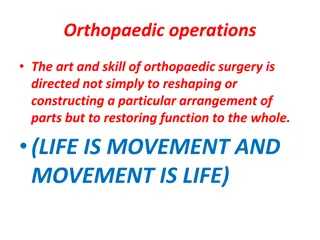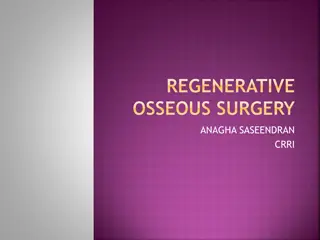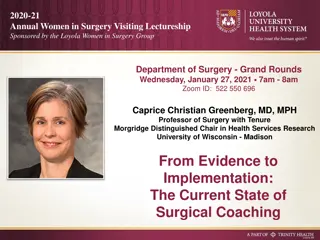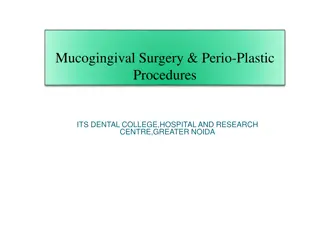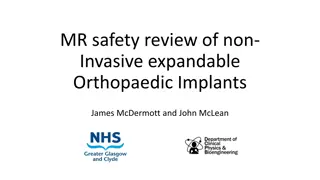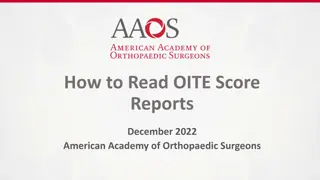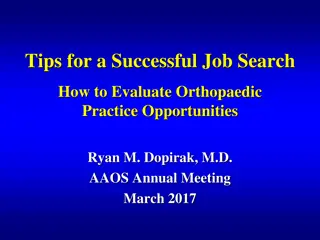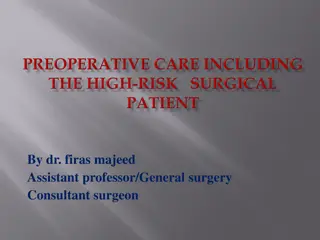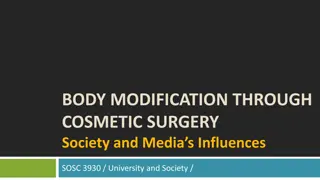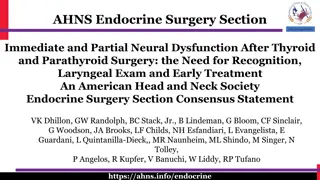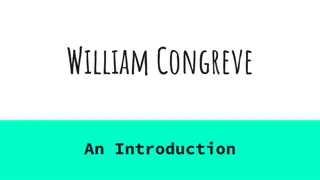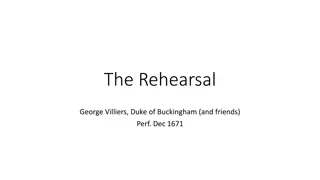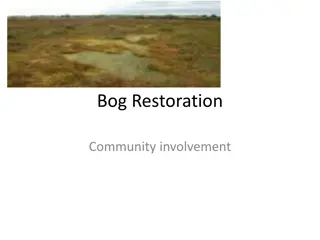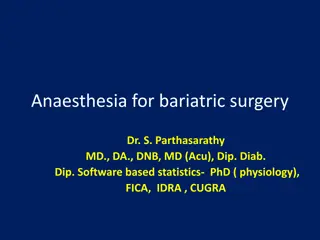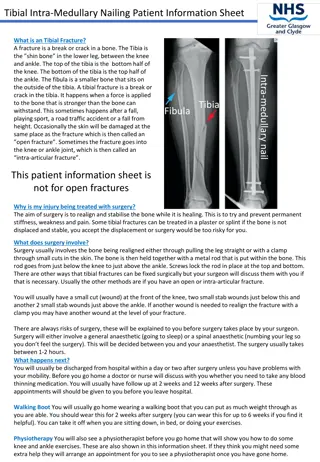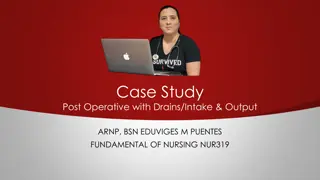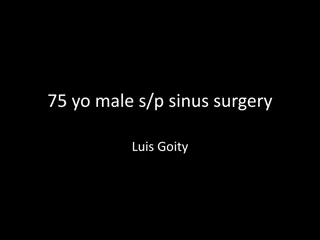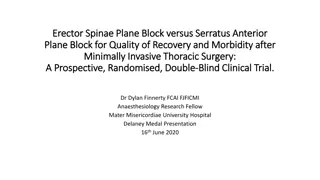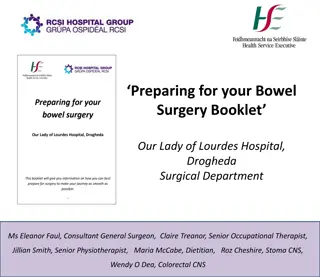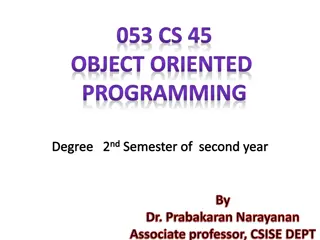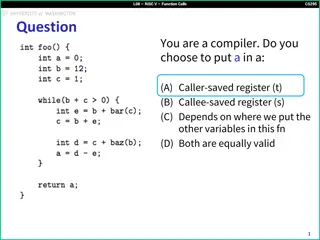Orthopaedic Surgery Techniques: Reshaping Function for Restoration
Orthopaedic surgery focuses on restoring function to the whole body through operations on bones and joints, including osteotomy, bone fixation, arthrotomy, arthrodesis, and arthroplasty. The indications and techniques for amputations are also discussed, emphasizing the importance of selecting the appropriate site for surgery. Proper surgical principles, such as using a tourniquet and creating skin flaps of specific lengths, play a crucial role in achieving successful outcomes.
Download Presentation

Please find below an Image/Link to download the presentation.
The content on the website is provided AS IS for your information and personal use only. It may not be sold, licensed, or shared on other websites without obtaining consent from the author. Download presentation by click this link. If you encounter any issues during the download, it is possible that the publisher has removed the file from their server.
E N D
Presentation Transcript
Orthopaedic operations The art and skill of orthopaedic surgery is directed not simply to reshaping or constructing a particular arrangement of parts but to restoring function to the whole. (LIFE IS MOVEMENT AND MOVEMENT IS LIFE)
A-OPERATIONS ON BONES OSTEOTOMY. BONE FIXATION (internal or external fixation). BONE GRAFT. B-OPERATIONS ON JOINTS ARTHROTOMY ARTHRODESIS ARTHROPLASTY
AMPUTATIONS INDICATIONS: - Three Ds : (1) Dead. (2) Dangerous . (3) Damned nuisance.
1-Dead (or dying) Peripheral vascular disease accounts for almost 90 per cent of all amputations. Other causes of limb death are severe trauma, burns and frostbite. 2-Dangerous Dangerous disorders are malignant tumours, potentially lethal sepsis and crush injury. In crush injury, releasing the compression may result in renal failure (the crush syndrome). 3-Damned nuisance Retaining the limb may be worse than having no limb at all. This may be because of: (1) pain; (2) gross malformation; (3) recurrent sepsis or (4) severe loss of function. The combination of deformity and loss of sensation is particularly trying, and in the lower limb is likely to result in pressure ulceration.
AMPUTATIONS AT SITES OF ELECTION Most lower limb amputations are for ischaemic disease and are performed through the site of election below the most distal palpable pulse. The selection of amputation level can be aided by Doppler US. The sites of election are determined also by the demands of prosthetic design and local function. Too short a stump may tend to slip out of the prosthesis. Too long a stump may have inadequate circulation and can become painful, or ulcerate; moreover, it complicates the incorporation of a joint in the prosthesis
The traditional sites of election;the scar is made terminalbecause these are not endbearing stumps.
PRINCIPLES OF TECHNIQUE A tourniquet is used unless there is arteria insufficiency. Skin flaps are cut so that their combined length equals 1.5 times the width of the limb at the site of amputation. As a rule anterior and posterior flaps of equal length are used for the upper limb and for transfemoral (above-knee) amputations; below the knee a long posterior flap is usual. Muscles are divided distal to the proposed site of bone section. It is also helpful to pass the sutures that anchor the opposing muscle groups through drill-holes in the bone end, creating an osteomyodesis. Nerves are divided proximal to the bone cut to ensure a cut nerve end will not bear weight
The bone is sawn across at the proposed level. In trans-tibial amputations the front of the tibia is usually bevelled and filed to create a smoothly rounded contour; the fibula is cut 3 cm shorter. The main vessels are tied, the tourniquet is removed and every bleeding point meticulously ligated.The skin is sutured carefully without tension. Suction drainage is advised and the stump covered without constricting passes of bandage; figure-of eight passes are better suited and prevent the creation of a venous tourniquet proximal to the stump.
AFTERCARE If a haematoma forms, it is evacuated as soon as possible. After satisfactory wound healing, gradualcompression stump socks are used to help shrink the stump and produce a conical limb-end. The muscles must be exercised, the joints kept mobile and the patient taught to use his prosthesis.
AMPUTATIONS OTHER THAN AT SITES OF ELECTION 1-Interscapulo-thoracic (forequarter amputation) 2-Disarticulation at the shoulder 3-Amputation in the forearm 4-Amputations in the hand 5-Hemipelvectomy (hindquarter amputation) 6-Disarticulation through the hip 7-Transfemoral amputations (Above KneeAmputation) 8-Around the knee 9-Transtibial (below-knee) amputations 10-Above the ankle Syme s amputation 11-Partial foot amputation
COMPLICATIONS OF AMPUTATION STUMPS A-EARLY COMPLICATIONS 1-Breakdown of skin flaps This may be due to ischaemia,suturing under excess tension or (in below-knee amputations) an unduly long tibia pressing against the flap. 2-Gas gangrene Clostridia and spores from the perineum may infect a high above-knee amputation (or reamputation), especially if performed through ischaemic tissue. 3-secondary haemorrhage.
LATE COMPLICATIONS 1-Skin Eczema is common, and tender purulent lumps may develop in the groin. A rest from the prosthesis is indicated. 2-Muscle If too much muscle is left at the end of the stump, the resulting unstable cushion induces a feeling of insecurity that may prevent proper use of a prosthesis; if so, the excess soft tissue must be excised. 3-Blood supply Poor circulation gives a cold, blue stump that is liable to ulcerate. This problem chiefly arises with below-knee amputations and often re-amputation is necessary.
4-Nerve A cut nerve always forms a neuroma and occasionally this is painful and tender. Excising 3 cm of the nerve above the neuroma sometimes succeeds. Phantom limb This term is used to describe the feeling that the amputated limb is still present. 5-Joint The joint above an amputation may be stiff or deformed. A common deformity is fixed flexion and fixed abduction at the hip in above-knee stumps (because the adductors and hamstring muscles have been divided). It should be prevented by exercises. Fixed flexion at the knee makes it difficult to walk properly and should also be prevented. 6-Bone a spur often forms at the end of the bone, but is usually painless. If there has been infection, however, the spur may be large and painful and it may be necessary to excise the end of the bone with the spur.


